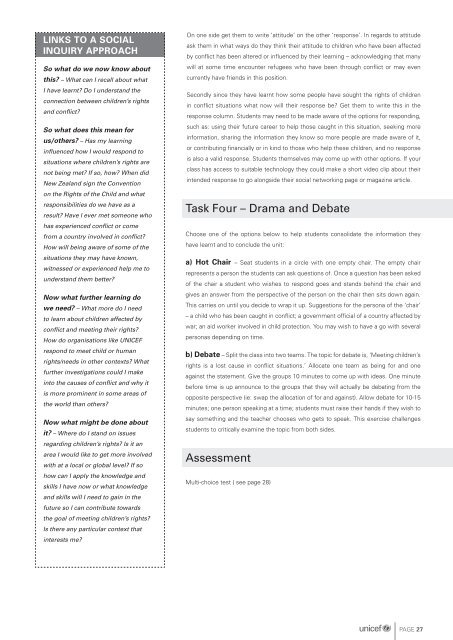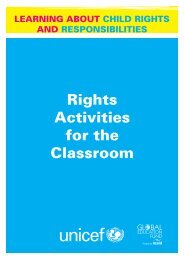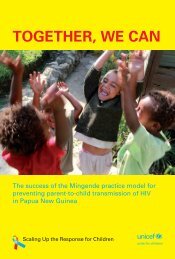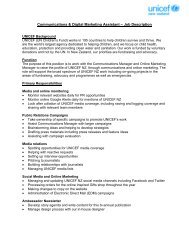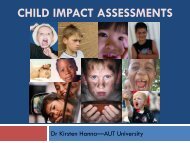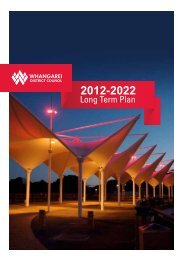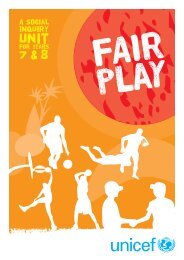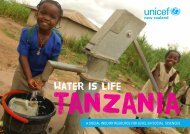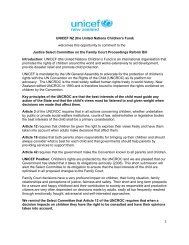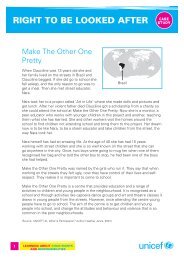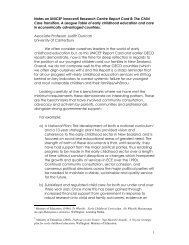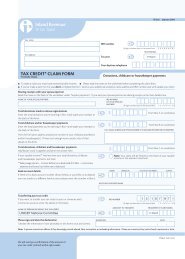Caught in the Crossfire pdf - Unicef
Caught in the Crossfire pdf - Unicef
Caught in the Crossfire pdf - Unicef
You also want an ePaper? Increase the reach of your titles
YUMPU automatically turns print PDFs into web optimized ePapers that Google loves.
LINKS TO A SOCIAL<br />
INQUIRY APPROACH<br />
So what do we now know about<br />
this? – What can I recall about what<br />
I have learnt? Do I understand <strong>the</strong><br />
connection between children’s rights<br />
and conflict?<br />
So what does this mean for<br />
us/o<strong>the</strong>rs? – Has my learn<strong>in</strong>g<br />
<strong>in</strong>fluenced how I would respond to<br />
TEACHING<br />
situations where children’s<br />
POINTrights are<br />
not be<strong>in</strong>g met? If so, how? When did<br />
New Zealand sign <strong>the</strong> Convention<br />
on <strong>the</strong> Rights of <strong>the</strong> Child and what<br />
responsibilities do we have as a<br />
result? Have I ever met someone who<br />
has experienced conflict or come<br />
from a country <strong>in</strong>volved <strong>in</strong> conflict?<br />
How will be<strong>in</strong>g aware of some of <strong>the</strong><br />
situations <strong>the</strong>y may have known,<br />
witnessed or experienced help me to<br />
understand <strong>the</strong>m better?<br />
Now what fur<strong>the</strong>r learn<strong>in</strong>g do<br />
we need? – What more do I need<br />
to learn about children affected by<br />
conflict and meet<strong>in</strong>g <strong>the</strong>ir rights?<br />
How do organisations like UNICEF<br />
respond to meet child or human<br />
rights/needs <strong>in</strong> o<strong>the</strong>r contexts? What<br />
fur<strong>the</strong>r <strong>in</strong>vestigations could I make<br />
<strong>in</strong>to <strong>the</strong> causes of conflict and why it<br />
is more prom<strong>in</strong>ent <strong>in</strong> some areas of<br />
<strong>the</strong> world than o<strong>the</strong>rs?<br />
Now what might be done about<br />
it? – Where do I stand on issues<br />
regard<strong>in</strong>g children’s rights? Is it an<br />
area I would like to get more <strong>in</strong>volved<br />
with at a local or global level? If so<br />
how can I apply <strong>the</strong> knowledge and<br />
skills I have now or what knowledge<br />
and skills will I need to ga<strong>in</strong> <strong>in</strong> <strong>the</strong><br />
future so I can contribute towards<br />
<strong>the</strong> goal of meet<strong>in</strong>g children’s rights?<br />
Is <strong>the</strong>re any particular context that<br />
<strong>in</strong>terests me?<br />
On one side get <strong>the</strong>m to write ‘attitude’ on <strong>the</strong> o<strong>the</strong>r ‘response’. In regards to attitude<br />
ask <strong>the</strong>m <strong>in</strong> what ways do <strong>the</strong>y th<strong>in</strong>k <strong>the</strong>ir attitude to children who have been affected<br />
by conflict has been altered or <strong>in</strong>fluenced by <strong>the</strong>ir learn<strong>in</strong>g – acknowledg<strong>in</strong>g that many<br />
will at some time encounter refugees who have been through conflict or may even<br />
currently have friends <strong>in</strong> this position.<br />
Secondly s<strong>in</strong>ce <strong>the</strong>y have learnt how some people have sought <strong>the</strong> rights of children<br />
<strong>in</strong> conflict situations what now will <strong>the</strong>ir response be? Get <strong>the</strong>m to write this <strong>in</strong> <strong>the</strong><br />
response column. Students may need to be made aware of <strong>the</strong> options for respond<strong>in</strong>g,<br />
such as: us<strong>in</strong>g <strong>the</strong>ir future career to help those caught <strong>in</strong> this situation, seek<strong>in</strong>g more<br />
<strong>in</strong>formation, shar<strong>in</strong>g <strong>the</strong> <strong>in</strong>formation <strong>the</strong>y know so more people are made aware of it,<br />
or contribut<strong>in</strong>g f<strong>in</strong>ancially or <strong>in</strong> k<strong>in</strong>d to those who help <strong>the</strong>se children, and no response<br />
is also a valid response. Students <strong>the</strong>mselves may come up with o<strong>the</strong>r options. If your<br />
class has access to suitable technology <strong>the</strong>y could make a short video clip about <strong>the</strong>ir<br />
<strong>in</strong>tended response to go alongside <strong>the</strong>ir social network<strong>in</strong>g page or magaz<strong>in</strong>e article.<br />
Task Four – Drama and Debate<br />
Choose one of <strong>the</strong> options below to help students consolidate <strong>the</strong> <strong>in</strong>formation <strong>the</strong>y<br />
have learnt and to conclude <strong>the</strong> unit:<br />
a) Hot Chair – Seat students <strong>in</strong> a circle with one empty chair. The empty chair<br />
represents a person <strong>the</strong> students can ask questions of. Once a question has been asked<br />
of <strong>the</strong> chair a student who wishes to respond goes and stands beh<strong>in</strong>d <strong>the</strong> chair and<br />
gives an answer from <strong>the</strong> perspective of <strong>the</strong> person on <strong>the</strong> chair <strong>the</strong>n sits down aga<strong>in</strong>.<br />
This carries on until you decide to wrap it up. Suggestions for <strong>the</strong> persona of <strong>the</strong> ‘chair’<br />
– a child who has been caught <strong>in</strong> conflict; a government official of a country affected by<br />
war; an aid worker <strong>in</strong>volved <strong>in</strong> child protection. You may wish to have a go with several<br />
personas depend<strong>in</strong>g on time.<br />
b) Debate – Split <strong>the</strong> class <strong>in</strong>to two teams. The topic for debate is, ‘Meet<strong>in</strong>g children’s<br />
rights is a lost cause <strong>in</strong> conflict situations.’ Allocate one team as be<strong>in</strong>g for and one<br />
aga<strong>in</strong>st <strong>the</strong> statement. Give <strong>the</strong> groups 10 m<strong>in</strong>utes to come up with ideas. One m<strong>in</strong>ute<br />
before time is up announce to <strong>the</strong> groups that <strong>the</strong>y will actually be debat<strong>in</strong>g from <strong>the</strong><br />
opposite perspective (ie: swap <strong>the</strong> allocation of for and aga<strong>in</strong>st). Allow debate for 10-15<br />
m<strong>in</strong>utes; one person speak<strong>in</strong>g at a time; students must raise <strong>the</strong>ir hands if <strong>the</strong>y wish to<br />
say someth<strong>in</strong>g and <strong>the</strong> teacher chooses who gets to speak. This exercise challenges<br />
students to critically exam<strong>in</strong>e <strong>the</strong> topic from both sides.<br />
Assessment<br />
Multi-choice test ( see page 28)<br />
PAGE 27


